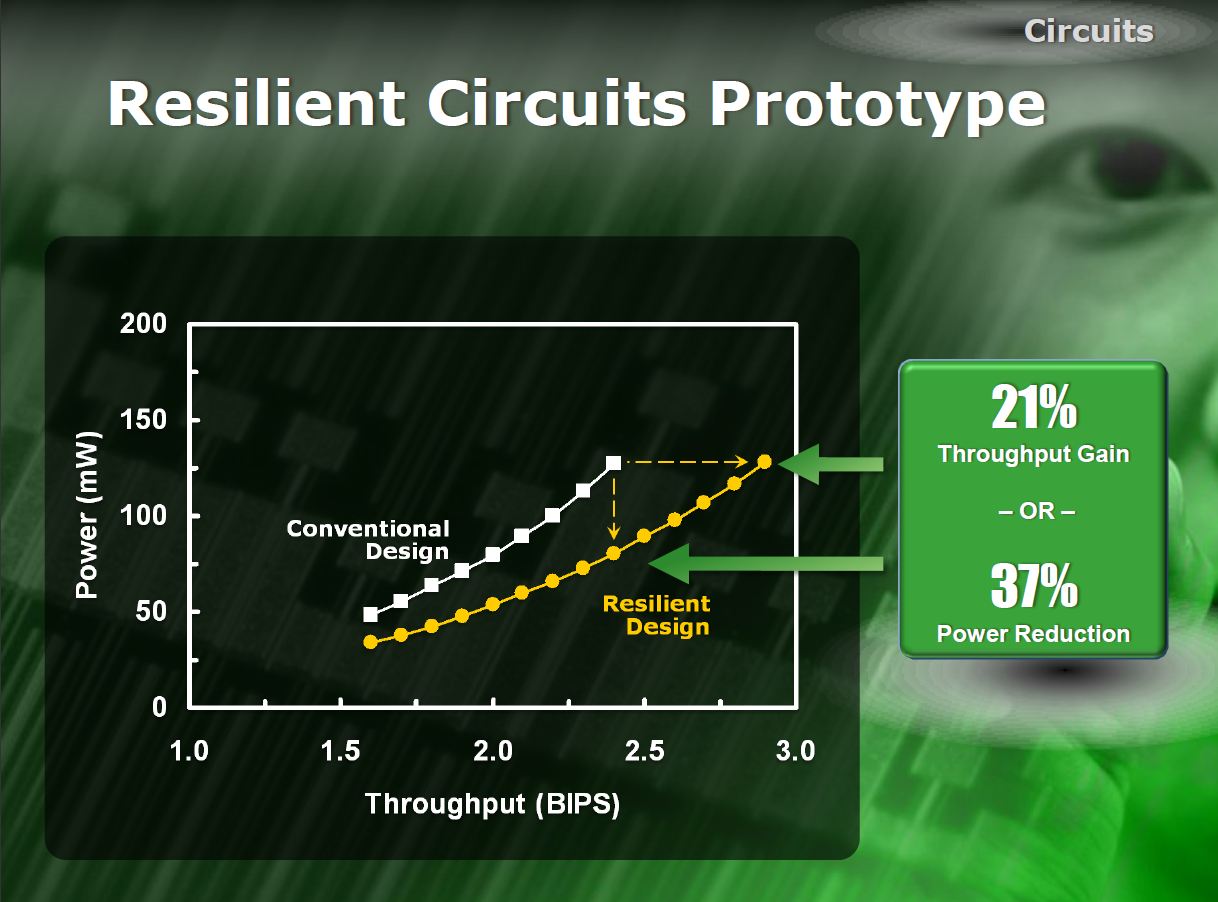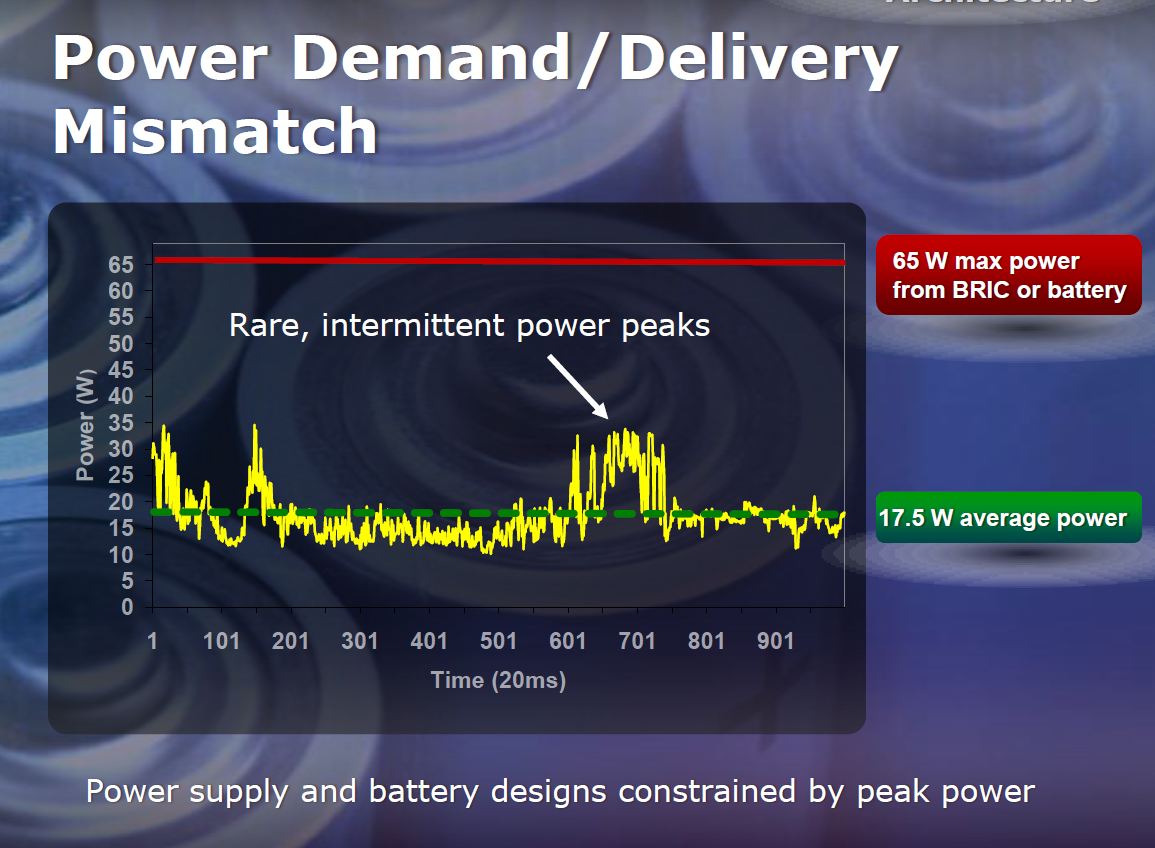Intel Developer Forum, Day Three: All About Power
Intel Research Briefing: All About Power
Andrew Chien, who runs Intel’s Future Technologies group, talked about energy. Specifically, he talked about the Smart Grid, which adds intelligence, communication, and energy storage into the power grid. The net result can be more efficient delivery of power where it’s needed. Of course, the Smart Grid will benefit Intel, since it’s nothing more than a gigantic information technology project.
Smart grids imply things like smart buildings, too. There are huge efficiencies that could be gained merely by making existing appliances and home electronics more efficient. The technology for smart grids is scalable down to individual homes. Intel showed a simple monitoring device that could attach to your home wiring and recognize an individual device or appliance by identifying the pattern of its actual power ramp as it starts up. This can give a homeowner the data needed in order to intelligently target where improvements can be most effective in reducing power consumption.
Perhaps more interesting to PC users was Wen-Hann Wang's discussion of the company’s overall approach to power management, including some interesting peeks at new developments.
Resilient Circuits. Modern CPUs often have limits placed on them by guard bands, which can restrict the performance of the CPU, but prevent rare error conditions when a circuit is overdriven. Resilient circuits build in error monitoring to detect those instances, and if spotted, can slow the circuit down or reduce voltage. The net result is either an improvement in overall throughput or a reduction in overall power usage. Early tests show throughput increases of up to 21% or power reductions of 37% by removing guard bands and implementing resilient circuits.
Super Capacitor Augmentation. Today’s mobile PCs require substantial batteries that can deliver high levels of current on demand. Similarly, the power bricks that attach to wall power must deliver relatively high current loads. What’s interesting is that those high current loads are really only needed during very short, transient peaks of system performance.
If you build capacitors into the battery and power bricks, the size of those batteries and power bricks can be substantially smaller and lighter. Interestingly, the actual energy stored in the battery can be increased, but the battery is lighter due to removing the need to deliver beefy amounts of transient power.
Low-Power Network Agent. Users increasingly want access to the data on their home PCs. If you imagine thousands of people leaving their PCs on, even in a fairly low-power state, that’s potentially millions of kilowatt-hours of power wasted when no one actually needs access to those powered up PCs.
Get Tom's Hardware's best news and in-depth reviews, straight to your inbox.
Imagine now a very low-power network agent that can be “told” through a script what types of access are important or not, and also have some limited storage. If a user simply sends data to the PC to be uploaded, the network agent can temporarily store it. If an urgent request to retrieve data from the PC is sent, the network agent can wake up the PC and deliver the data. Since the PC is off most of the time, substantial power savings can be realized.
Current page: Intel Research Briefing: All About Power
Next Page Toshiba, SSDs, And More USB 3.0-
burnley14 It sounds like Toshiba is developing a SSD that plugs directly into a SATA port, which sounds ideal as long as it's bootable, even if the storage is limited. Now just work on making it cheaper . . .Reply -
ceteras burnley14It sounds like Toshiba is developing a SSD that plugs directly into a SATA port, which sounds ideal as long as it's bootable, even if the storage is limited. Now just work on making it cheaper . . .What do you mean by "as long as it's bootable". How on Earth do you imagine they could make it non-bootable?Reply
A SSD that plugs directly into a SATA port would be a standard SATA device, only smaller, and using the right connector to fit the one on the mainboard. Of course it needs another one for power.
Perhaps it will look like this one, only it should be even smaller and a lot faster.
-
To me, Clarkdale is definitely the most interesting of the new Intel products. With built-in HD acceleration and high-definition audio bitstreaming (according to Anandtech), it looks like this is going to be THE chip for HTPC applications. At least it will be if they can ensure that 24p output works smoothly (it didn't with the G45, at least at first - not sure if that was ever fixed), and ensure that there are no other major showstoppers.Reply
Intel is usually pretty good about Linux driver support, so I really hope that their Linux drivers will support the TrueHD/DTS-MA bitstreaming functions. It would be great if XBMC for Linux could bitstream these formats from MKV files. This would ensure zero quality loss from Blu-Ray backups. -
alexie paying $200 to CPU+GPU and also paying 50-70$ or more to mainboard for a PC with clarkdale and also paying another $100 or more for extra GPU???Reply
I'd rather go core i5 :)
I think Intel needs to make something more to clarkdale for us to buy it.
Do you? -
WINTERLORD from the way it was worded about intel aqnd gulftown 6core processor well with all the intigration of stuff ect. i sure hopoe gulftown aint a disappiontment. also i was under the impression that the 1366 would support an 8core 16 process through hyper thread. hope all this stuff holds true in the long run would sure like to see it stay on the 1366 socket awhileReply -
I hope the integrated GPU can work together with the discrete GPU to add some value. At least be able to switch between them without going to the BIOS.Reply
-
anamaniac Very impressive.Reply
For some, the integrated GPU works perfectly fine. Unless gaming/CAD/photoshop etc., you have no use for anything else.
I know this would work fine for most. Starcraft/Warcraft3/WoW (guess this would be a large market share they would want to target)/CS:S etc. would all run perfectly fine on it. Most people can use a solo core and never even notice.
Honestly, my old integrated graphics/1.6Hz celeron (not a atom) works just fine (well, before it burned out recently). My i7 and descrete graphics is just for hardcire gaming AND bragging rights.
I imagine this will be far under $200 (Intel claimed its integrated graphics cost OEMs about $7 a peice, and being a dual core, it's gonna be cheap likely). Lets assume $150 CPU, $100 MOBO, $50 RAM, $50 HDD, $20 DVD, $30 case, $40 PSU, $5 mouse, $15 keyboard, $20 speakers, $100 1024p monitor and it all racks to $580 for a complete system that would still kick ass.
It's a dual core, it's not aimed for gamers, so deal with it. =D



